The Electrostatic “Sonic Panel” – Interview with Charlie van Dongen and Rob Mackinlay
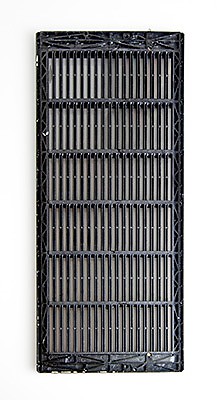 I was intrigued recently to learn of a new electrostatic panel from Australian company Involve Audio. Designed originally for OEM applications, the panel, called the Sonic Panel, or by its product name UFPS-440, is used in the Liquid Base SonicBlades loudspeaker, winner of a CES 2012 Innovations Award. It is now also available for DIY applications as a standalone panel together with the necessary power supplies and stepup transformer, which of course piqued my interest.
I was intrigued recently to learn of a new electrostatic panel from Australian company Involve Audio. Designed originally for OEM applications, the panel, called the Sonic Panel, or by its product name UFPS-440, is used in the Liquid Base SonicBlades loudspeaker, winner of a CES 2012 Innovations Award. It is now also available for DIY applications as a standalone panel together with the necessary power supplies and stepup transformer, which of course piqued my interest.
I asked Charlie Van Dongen, the chief designer of Involve Audio, and Rob Mackinlay of E R Audio, who has been developing electrostatic loudspeakers for many years and was also involved in the design, if they would give us some background on the panel and provide tips for those interested in using the panel in their own projects.
JR: Charlie, Rob, thank you for speaking with Hifi Zine. As far as I’m aware, the Sonic Panel is unique – no other company makes a standalone electrostatic panel in this size and form factor?
CVD: Yes I agree, we know of no other in kit form. Rob makes several larger panels available in kit form.
RM: Indeed, the 440 panel (the 440 relates to its size) is a very versatile driver. It can be used singly or in a vertical array to create a true line source with higher max SPL. It can even be used in a faceted array to create excellent horizontal dispersion rather like the older and smaller Janszen panels from the 60’s and 70’s.
JR: What motivated this particular form factor for the panel?
CVD: The majority of the consumer audio market has moved to the smaller bookshelf style format. In addition, the plastic mold for this size is more practical to achieve.
RM: I think versatility was another factor that was given in-depth consideration. The panel can be used in a simple 2.1 bookshelf application, in 2-way hybrid bookshelf speakers or a larger floor standing speaker using one or two panels in a stacked array. Wall mounting is also a practical option provided the correct mountings are used.

JR: Charlie, the technology in the panel is, I assume, an evolution of that used in the Nakamichi Dragon and Whise HA1500 loudspeakers? Can you tell us more about those speakers?
CVD: The origins of the electrostatic speaker actually came about on a Christmas holiday in 1995. I felt there was an opportunity in a “value added” product in electrostatic loudspeakers, as the biggest limitation of any hifi system is typically the speakers. If you walk into any hifi shop all you see is ports, cones, crossovers and boxes – they are all very similar and create a “boxy” non-live unnatural sound. Electrostatics offered the potential advantage of being essentially flat with a performance that in many areas far exceeded cone boxes. However, electrostatics were very labour-intensive, unreliable, fragile, no bass, narrow dispersion, low output, and needed huge amplifiers to power them. In some ways, they were the perfect midrange transducer.
I began to research developments in electrostatic technology and discovered that Mr. Rob Mackinlay of E R Audio in Western Australia had done some really innovative stuff in regards to the design and manufacturability of electrostatics. Upon contacting Rob we decided to work together to develop an electrostatic loudspeaker to address the above shortcomings. This resulted in my company at the time, Vass Electronics Pty Ltd, releasing a number of electrostatic loudspeakers in 1996 to 2000. Unfortunately, Vass Electronics was forced to close down in 2002.
A few year later, I and Lindsay Champion of Winovate Pty Ltd pursued possible markets to revitalize the speaker technology, and approached Nakamichi Pty Ltd of Japan who immediately showed great interest. You may remember that in the mid 1970’s and 1980’s Nakamichi were the world leader in cassette player technology and had obtained a legendary name in the HiFi industry. Recently they had been competing against names such as Bose and B+O in style-based “HiFi” with falling sales and market share. They wanted to effectively restart the Nakamichi name with technological superiority and market from that superiority, and saw our electrostatic speaker technology as the edge they needed.
The resulting speaker, the Nakamichi Dragon / Whise HA1500 had many novel design features, such as rod-based stators, 35 mm dispersion strip, dual 100 W active amplification, Whise dual 8-inch woofer with external acoustic filter, 3.5 micron mylar, and a rear polar dispersion reflector column. I know I am biased but they were way better than the MartinLogan Summits (I had a set).
We obtained final quality and technology approval from no less than Kozo Kobayashi, designer of the 1000 and other Nakamichi cassette decks and arguably the best audio engineer of last century. Unfortunately, Nakamichi’s parent company, “The Grande Group,” encountered a $700 million dollar loss and needed to cut costs (others in the group were Akai, Emerson and Sansui); the end result was that we were left with both stock and a factory in China, and no orders. The remaining stock have now all been sold as the Whise HA1500.
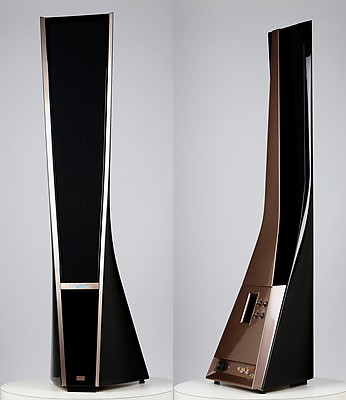
Whise HA1500 electrostatic hybrid loudspeaker
JR: Rob, you have been supplying full-sized electrostatic loudspeaker kits for some time now. Can you tell us a bit about that, and about your design involvement with the sonic panels?
RM: I started E R Audio in 1993 following some successful experiments with ESL’s of my own design.
I’m a mechanical engineer with some electronics knowledge (enough to get me into deep trouble). I bought a pair of Australian-made ESL’s (basically a MartinLogan CLS copy!) around 25 years ago as I liked some of the things they did, even though I knew they had some serious shortcomings at the frequency extremes. After living with them for a while, I became a bit dissatisfied so I started “improving” them. The system ended up quite cumbersome – tri-amped, additional bass and HF drivers – but still was not what I wanted so the thought “how hard can it be to design something better?” came to mind. I read all of the patents that were out on the subject and contacted the repair agents for the then-current range of ESL’s to see what went wrong with them.
I then designed and built an ESL that I considered addressed most of the issues. The first try was quite good which gave me more enthusiasm and led to further improvements. Having got the speaker working quite well it became my speaker of choice. At this time I was the president of the local audio society and, because of their resolution, we would use these ESL’s for component comparisons etc. This gave them some exposure to the real world and opened the door for friends who had bought ESL’s that had started to become troublesome to ask me to fix them, or to build them some replacement ESLs. This I did. So, I started to gain experience with other manufacturers’ products from both ends of the spectrum – what they did well and what they did badly.
This experience led to more ESL designs of my own which I now market as DIY kits. During this time I had a DIY ESL project published by Silicon Chip, the Australian electronics magazine (Silicon Chip, February, March, April, 1995). This brought considerable interest in my kit ESL’s and brought me to the attention of Charlie Van Dongen. Over the years, Charlie and I collaborated on several different speaker designs, some of which came to fruition while others remain on the back-burner for future development. The most important of these were the Nakamichi Dragon hybrid and the 440 sonic panels.
E R Audio continues to sell a range of larger ESL DIY kits as well as fully completed sonic panels.
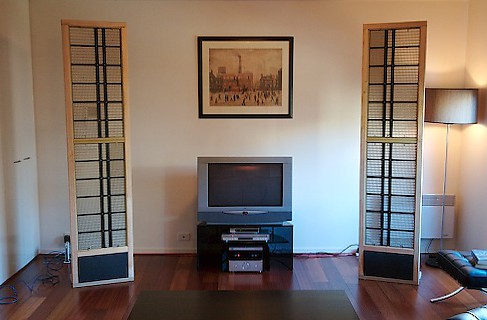
E R Audio Acorn electrostatic speakers (assembled by Greg in Melbourne)
JR: For those interested in applying the panel in their own projects, are there any specific configurations that you would suggest as being more optimal usage than others?
RM: The panels were originally designed for bookshelf / small room application. The vertical dispersion is not great as they are tall enough to limit dispersion, but not tall enough for you not to be able to move out of the vertical sweet spot. They do work well in the near and far fields as the sound tends to propagate in an expanding wave, and close up you are in the sound field anyway. My recommendation would be to rake them backwards, which will improve vertical dispersion without sacrificing accuracy when seated. Alternatively, for larger rooms stack 2 pairs! That will give you a 6 dB increase in output and a true line source.
CVD: The panels are quite sensitive at 88 dB/W/m but are only useful to say 200 Hz, so it is essential to blend them with a good woofer configuration. Whilst they look better with no cloth, from an acoustic point of view they have a better more damped bottom end response with the cloth.
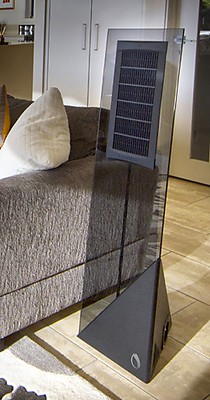
Liquid Base electrostatic hybrid loudspeaker
JR: We used to be told that our Quad ESLs needed 24 hours to come up to optimal operating charge. Is there any such charge time or warmup time with these panels?
CVD: They are really fast and are within 2 dB of maximum SPL in 30 seconds.
RM: The conductive coating that is used on the sonic panels accepts charge very quickly without relying on ambient humidity to make it work. This results in a speaker that reaches full output within a few minutes of being powered up. While the sonic panels can be left powered continually, it is not really necessary to do so because of the fast charge capability.
JR: What about arcing? My understanding is that these panels won’t arc, no matter what you do – is that correct, and what is it about them that prevents arcing?
CVD: It is difficult to give a 100% assurance as some manufacturing defect could prove me wrong but we have had very few failures, and as the production of the panels has increased the quality of the process has improved. We have invested a lot of time researching many forms of insulation coating on the arrays that have been successful, and in addition the secondaries of the transformers have a number of series MOV’s built-in to limit peaks. We also recommend the use of input overload suppression techniques.
RM: There are really 2 types of arcing in an ESL. The first is an arc that may occur from a stator to the diaphragm. This is usually a trivial event and mostly goes unnoticed because of the very high surface resistivity of the coating on the diaphragm. The arc will discharge a tiny area of the diaphragm, but because the surface is resistive, the charge on the full surface area of the diaphragm cannot flow into the arc.
The other type of arc is from stator to stator – this is more serious as it will burn a small hole in the diaphragm and, if allowed to persist, will eventually burn sections of the stators. The arcing threshold will decrease because of this, making the speaker only usable up to moderate listening levels.
The 440 panel has a protection device (MOV) that clamps the voltage supplied to the panels at a preset maximum level, protecting them from damage.
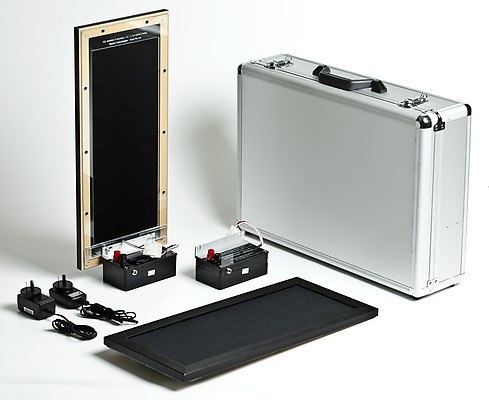
Sonic Panel evaluation kit (DIY panel kit does not include frame, carrying case, or lids for electronics module)
JR: The panels come supplied with a “sock.” Is this better left on or off?
CVD: The sock is best kept on as it controls the bottom resonance frequency which if left untreated can peak 10 dB.
RM: As well as the damping effect the sock excludes dust and insects from the inner works. While these are not necessarily a problem in themselves, they do have to be cleaned out carefully with a vacuum cleaner set on low suction so they do not create leakage of the high polarising voltage.
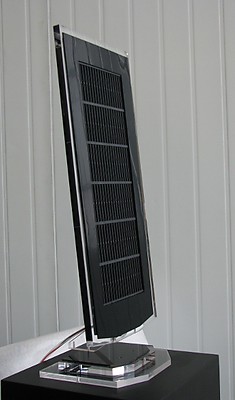
Acrylic stand for sonic panels (not included, enquire for pricing)
JR: There’s been some interest in using the panels as a midrange driver. What’s your thought on that?
CVD: I agree they are well suited but frankly they are really good down to say 250 Hz so why put in additional crossovers? Top end dispersion is better than what most people expect from electrostatics and so if I was to use a tweeter it would be from say 5kHz and above.
RM: IMHO the fewer drivers the better. This eliminates difficulties with integration of other drivers, which may have different sonic signatures.
In theory, a single diaphragm delivering full-range sound is ideal, no crossovers or different drivers to deal with. In practice this layout has conflicting requirements and is not ideal, the bass needs to be driven harder than the higher frequencies to cater for LF cancellation effects. The diaphragm must have good excursion capabilities for LF but this is not optimal for HF. There will also be a degree of intermodulation distortion (IMD) because the diaphragm is being asked to deliver say 40 Hz (high excursion) and 5 kHz at the same time. This means that the higher frequencies will only be accurate when the diaphragm passes through the centreline between the stators.
On top of this, horizontal dispersion of high frequencies will be poor due to the width of the panel required for low frequencies. The use of the 440 panel from say 250Hz (perhaps a little lower) to 20 kHz is recommended for best results.
JR: Let’s close with some of what motivates all of this in the first place. What keeps you going, and who are some of your favorite artists?
CVD: I have been an audio nutter for 40 years but my motivation is also commercially related. If someone came to me with a business plan to make another cone-based box speaker with ports, crossovers and maybe a few curvy things I would be unlikely to take them seriously. The market today is for small and flat (e.g. LED televisions) and frankly the speakers of say 30 years ago are just as good as the current crop. As told to me years ago, if we are to make a leap in technology we have to effectively change from the piston engine to a jet engine! Electrostatic speakers offer so many technical advantages, and aside from the standard parameters deliver the sound as a dipole from one coherent location.
As for music choice I am, as Rob would tell you, rather unsophisticated – I love the blues, swamp (CCR, JJ Cale), rockabilly (Brian Setzer) and if anybody says anything bad about Sheryl Crow I can become quite irrational (check out her Detours album – much more to her than we get locally). Of the latest stuff check out Eddy Moran – A Girl Called Eddy was a flop commercially but I think it was one of the best releases in the last 10 years. She is so talented and underrated. Kimbra – she has great potential (if only she played the banjo).
RM: Ah music…… anything from Dvorak to Jazz to Pink Floyd (including Led Zep and Sabbath). The only genre of music I don’t like much, and there are some exceptions, is country. There’s only so much you can sing about dogs, women, trucks, gambling and buddies!!!
Fave artists are too numerous to mention but some would be Holly Cole, Patricia Barber, Radka Toneff, Pink Floyd, Dire Straits, Tony Joe White, Mark Cohn, Chris Rea, Eric Clapton, Mannheim Steamroller, Jim Brickman, Dead can Dance etc etc.
JR: Thank you very much, Charlie and Rob.
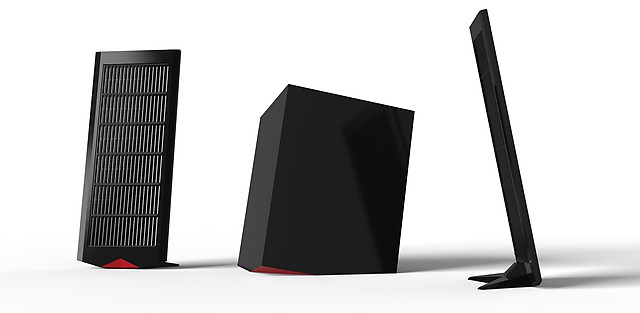
Forthcoming electrostatic bookshelf speaker
Specifications – UFPS-440 Ultra Flat Panel Speaker
- Frequency range: 200 Hz – 20,000 Hz
- THD: < 1%
- Polarisation voltage: Approx 2.5 kV
- HV power consumption: <0.05 W
- Impedance: Minimum 4 ohms
- Sensitivity: 88 dB
- Amplifier requirements: +/- 30 V or higher rails with peak current capability of 10 amps
- Dimensions (W x H x D): 168 x 440 x 8 mm (approx 6.2 x 17.3 x 0.3 inches)
- Weight: 440 g (approx 1 pound)
Availability and pricing
Available from Involve Audio and E R Audio. Pricing per pair: AUD410 for DIY panel kit, AUD495 for panel evaluation kit. Enquire with Involve Audio for OEM/quantity discounts.




Sounds damned appealing
To be realistic about likely limitations, three questions please:
“THD: < 1%" is a little vague but highish, and THD doesn't correlate well with hearing. How is the audible distortion vs other ESLs (commercial) that many of us have heard, eg Quad and Martin Logan?
If crossed say at 250 Hz with a 4th order, what is the maximum power handling and in particular the maximum SPL, while still keeping distortion low enough for that ESL "magic"?
What is the – 3 dB angle of vertical dispersion?
Cheers
Hi Rick, I’m assuming these questions are for Charlie and Rob? It would be best to contact them directly (contact info on their websites). Did you have a specific application in mind?
I have just bought a pair of Nakamichi Dragon HDA electrostatic speakers, can you suggest a source for an instruction manual please? Regards, Rick
Hi Richard, I expect if you contact Charlie at Involve Audio he would be able to help: http://www.involveaudio.com/pages/contact-us
Are your small electrostatic panels available in the United Kingdom and could they set up as five “satelite” speakers in a Dolby 5:1 system?
Cheers
John.
Hi John, re availability you will need to direct your query directly to Rob or Charlie, see website links in intro. On the question of satelite speakers, I think you’ll find they need a woofer underneath each, they don’t really go low enough to cross directly to a sub.
Enjoyed the article !
The last picture of the ESL speakers looks very much like Solo Static which I own.
Haven’t setup my HiFi back again.
Lost my PreAmp Audio Research SP5
My set up was:
Audio Research SP5 with AR End Amp class A, all tube for my Mid range ESL
2x Quad 405 (mono block 100watts)
2x Nakamichi filters for Sub woofer and Tweeter.
1x Tube amp Ampliton to drive my Ionefane flame tweeters.
Interlink with Silver cord cable.
I once tried Dynacord ESL which sounds nice on modern music, more direct and agressif. But the QUAD is much smoother & natural especially for classic music.
By telling all this, where can I listen the speakers on your article ?
I would like to hear it some where around Amsterdam or in Germany around Münster please.
Hi Grant, you would need to contact Involve Audio or ER Audio directly, links are in the last section of the article.